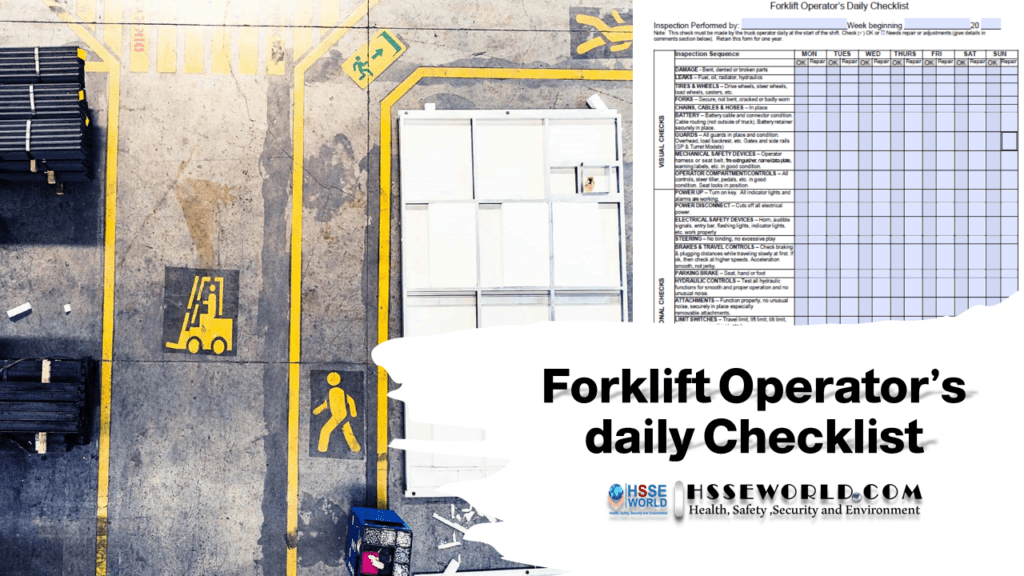Forklift Operator’s Daily Checklist and safety Tips
7 min readThe forklift is one of the most commonly used pieces of equipment on the worksite. These powered industrial trucks are used to lift and transport loads with deft and precision. Although forklifts are powerful, there is risk involved in operating any industrial machine. With over an estimated one million forklifts estimated to be in operation, it’s essential to ensure crews are trained on proper safety measures and operator inspect it using Forklift Operator’s Daily Checklist
The Occupational Health and Safety Administration (OSHA) estimates that forklift accidents cause roughly 34,900 serious injuries and 85 fatal accidents every year. Even more alarming is that 25 percent of these accidents are the result of inadequate training, showing the importance of educating every worker on the critical rules of safe forklift operation. in this article you will be able to download the Forklift Operator’s Daily Checklist and will be familiar with the most essential tips for forklift safety. ( Read : 4 Major Forklift Accidents and Prevention )

Get Forklift Certification
Since many accidents are due to poor training, it is recommended that only those who have been trained and licensed in accordance with OSHA standards be responsible for operating a forklift. Employers should evaluate their employees’ performance at least once every three years and supplement training with lectures, videos, software training, and demonstrations.
Wear Proper Clothing
Forklift operators should be dressed with the appropriate safety equipment, including safety shoes, hard hats, and a high-visibility jacket. Make sure to tuck away loose clothing to prevent it from getting caught on the forklift.
Know the Forklift Class
OSHA recognizes many different forklift types and classifications. Since each type has its own structure, weight limit, traveling speed, turning radius, and usage, it’s important to know your equipment in order to follow the best safety practices.
Inspect the Equipment Daily
Forklifts should be thoroughly inspected before every use. Daily checks with the shift supervisor and Operator are recommended to identify and log any problems or defects( use forklift operator’s daily checklist ) download below. Any equipment that requires repair should never be operated. Some of the recommended checks include:
- Test operating controls such as brakes, lights, horn, and steering wheel
- Check mast and overhead guard for damage
- Examine tire and fluid levels (hydraulic, brake, engine, fuel, and coolant)
- Check for water, oil, or radiator leaks
- Ensure the forks are in good condition (e.g. straight, no cracks, no distortion)
- Look for potential hazards

When using a forklift, it is important to follow all worksite rules, signs, and regulations. Here are some best practices to help you observe your operating environment and protect yourself and the other individuals on the worksite.
Maintain 360° Visibility
Keep forks low to the ground to provide clear forward visibility. If the load restricts your visibility, operate the equipment in reverse. Always ensure you have a good view of the rack when you are positioning the load. Additional best practices defined by OSHA are:
- Always make eye contact with pedestrians and other workers
- Always look in the direction of travel
- Use rear-view mirrors to boost visibility
- Use headlights if working at night, outdoors, or in areas where additional lighting is needed
You can read the rest of the tips on the OSHA website.
Implement a Floor Marking System
A floor marking system can help increase worker safety. Use yellow to mark physical hazards, such as areas prone to falling or stumbling, and red to delineate fire hazards, fire equipment and emergency switches. Place wayfinders and signs throughout the site to keep pedestrians away from forklift paths, lead forklifts along safe routes, and improve the overall flow of traffic.
Read more about :

Maintain Equipment Capacity
Be aware of the capacity of your forklift and any attachments used. Avoid hauling weight that exceeds the counterweight of the forklift. Overloading a forklift can cause the rear wheels to rise off the ground and the whole machine to fall over, causing injury to personnel and damage to the equipment and materials.
Never Carry Extra People
Do not allow other workers to ride on the equipment with you unless a second seat is fitted into the forklift. Do no use the forklift to lift people, as forklifts are designed to carry loads. If you need to lift a person, use only a secure work platform and cage.
Pay Attention to the Forklift’s Stability
Before using a forklift, make sure your hands and shoes are completely dry and sit in a comfortable position with all the controls within reach. In addition to seating yourself securely, take the following steps before operating the forklift to increase your safety.
Each forklift has a center of gravity – the point where the weight has equal concentration – that it shares with the load it carries. Forklifts are built on a three-point suspension system, called the “stability triangle” that operators must stay within to prevent it from tipping over. The heavier the load, the further out the center of gravity is from the load center, decreasing your forklift’s lifting capacity.
Ensure Loads are Stable and Secure
When placing loads on the loading dock, be sure to check them for balance. Travel with the load tilted backwards and keep forks as low as possible to increase the stability of the equipment, especially when navigating on ramps. Use ropes or bindings to secure stacks and heavy loads if necessary and make sure any pallets or skids used are the appropriate weight for the load.
( Read Operator dies when forklift falls off loading dock )
Move at the Appropriate Speed
Drive your forklift within the designated speed limits. It’s important to not stop, turn, change directions suddenly, or move fast when making sharp turns, as these actions can cause the forklift to tip over. If your forklift starts to dip, do not try to jump clear of the machine. Experts recommend staying in the vehicle, gripping the wheel, and bracing your feet.
Maintain a Safe Operating Distance
Always be mindful of the surrounding equipment on the worksite. Do not operate a forklift in close proximity to other machinery unless absolutely necessary, and keep a safe distance to allow you room to stop safely and avoid other machines that are moving in an unpredictable manner.
( Read Forklift Maintenance Tips)
Avoid Hazardous Areas of the Equipment
Avoid standing or walking under a load, lifting mechanism, or forklift attachment, as loads can fall off on anyone positioned below it. Keep hands and feet clear away from the forklift mast, as a moving mast can cause serious injury.
Refuel and Recharge the Forklift
It’s important to keep equipment fully charged and fueled. Be sure to recharge and refuel in specially designated locations, which are usually well-ventilated and flame-free areas. Be diligent in switching off the equipment every time it’s being refueled.
Park the Forklift at the End of the Shift
At the end of the shift, be sure to always park the equipment in the designated and authorized areas. The construction company should make sure the parking areas do not block pathways or obstruct any exits or entrances. Fully lower the forks until they fit the floor, apply the parking brake, turn off the engine, and remove the key from the ignition.
( Download : E-Books:Forklift Safety Guide )
Download the Checklists
These checklist not all-inclusive. You may wish to add to them or delete portions that do not apply to your workplace. Carefully consider each item as you come to it and then make your decision. Do not spend time with items that have no application to your workplace.
Forklift Operator’s Daily Checklist
More Forms
- Downloadable Kitchen Safety Inspection Checklist for Restaurants
- Mastering LOTO: Protecting Workers with Energy Isolation and Isolation Confirmation Certificates
- Flammable and Combustible Storage Checklist Free Download
- Secure Your Lifts:Guidelines for Safe Lifting Operations Free Planning Tool
- Sample of Accident Prevention Program ( APP) Template for General Industry Free Download
- Free ISO 14001:2015 Environmental Management System Audit Checklist Download
- Guides for Walking and Working Surfaces Safety Program
- Workshop Safety Guideline and free Posters
- Free Ergonomics Checklist for General Industry
- Work Area Safety Checklist
- Machine Safety and 43-Equipment Inspection Checklists
- Scaffold Safety self Audit and checklist
- Hot Work Controls and its Permit to work Form
- Safety Observation Report Template
- Forklift Operator’s Daily Checklist and safety Tips
- Inspecting Fall Protection Equipment Forms
- Templates: HSE Incentives and rewards
- 35 Inspection forms for Rig Check
- Chemical Risk Assessment form
- 22-Safety Inspection Checklists
- Safety Task Assessment Form
- Suspended Scaffold Pre-Operation Inspection Checklist
- Photo of the day: New worker Orientation & Safety Orientation checklist
- Grating-Decking-Floor- handrail-Removal Form
- Electrical Inspection Checklists
- E-Books: Fire Safety Logbook templates
- General Safety Guidelines and Employee Acknowledgment form
- Annual Internal Audit Form
- Mobile Scaffold Inspection checklist
- Simultaneous Operation (SIMOPS) checklist
- Temporary Construction Facilities (TCF) Inspection checklist
- HIRA, HSE Hazards & Effects Management Process (HEMP) & Risk Register Template
- Hazard Identification Plan (HIP) Template
- Ladder Inspection Form
- Free Pre-Startup Safety Review Checklist (PSSR)
- Hazard Identification Checklist
- Workplace Housekeeping Checklist
- ISO 45001:2018 READINESS CHECKLIST
- Lifting Plan Audit Checklist
- Job Safety Analysis (JSA) Forms What’s Right and Wrong?
- Electrical Isolation Permit to Work forms and checklist
- Canteen Inspection Checklist
- Work at Height Checklist
- Health Safety at Work Improvement Action Plan
- Fire Pump Daily Inspection Checklist
- Construction Site Traffic Management Plan (CSTMP) Guidance
- Safety Templates: COVID-19 Safety Plan
- Workplace Safety Inspections Forms
- Lock Removal Form
- Templates: Management of Change NEW Modified Equipment Safety Checklist
- Lifeline & Harness Inspection Guide checklist
- Contractor Pre-qualification Questionnaire Checklist
- Fall safety at construction checklist
- Construction safety Inspection checklist
- Equipment Safe Operating Procedures- SOP 61 checklist
- Permit to Work (PTW ) AUDIT CHECKLIST
- Hygiene and Sanitation Inspection Checklist



